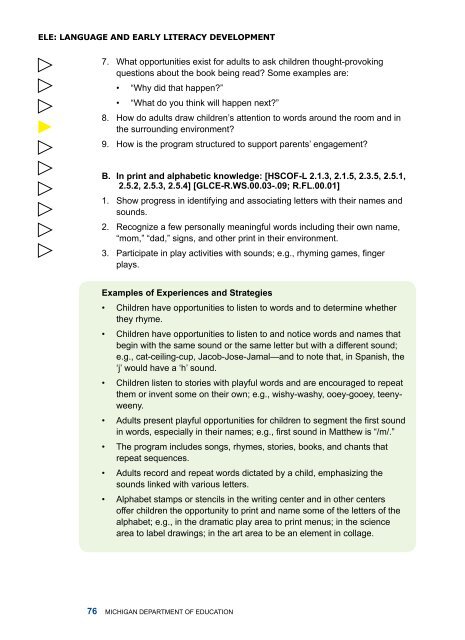Early Childhood Standards of Quality for ... - State of Michigan
Early Childhood Standards of Quality for ... - State of Michigan
Early Childhood Standards of Quality for ... - State of Michigan
Create successful ePaper yourself
Turn your PDF publications into a flip-book with our unique Google optimized e-Paper software.
ELE: Language and <strong>Early</strong> Literacy Development7. What opportunities exist <strong>for</strong> adults to ask children thought-provokingquestions about the book being read? Some examples are:• “Why did that happen?”• “What do you think will happen next?”8. How do adults draw children’s attention to words around the room and inthe surrounding environment?9. How is the program structured to support parents’ engagement?B. In print and alphabetic knowledge: [HSCOF-L 2.1.3, 2.1.5, 2.3.5, 2.5.1,2.5.2, 2.5.3, 2.5.4] [GLCE-R.WS.00.03-.09; R.FL.00.01]1. Show progress in identifying and associating letters with their names andsounds.2. Recognize a few personally meaningful words including their own name,“mom,” “dad,” signs, and other print in their environment.3. Participate in play activities with sounds; e.g., rhyming games, fingerplays.Examples <strong>of</strong> Experiences and Strategies• Children have opportunities to listen to words and to determine whetherthey rhyme.• Children have opportunities to listen to and notice words and names thatbegin with the same sound or the same letter but with a different sound;e.g., cat-ceiling-cup, Jacob-Jose-Jamal—and to note that, in Spanish, the‘j’ would have a ‘h’ sound.• Children listen to stories with playful words and are encouraged to repeatthem or invent some on their own; e.g., wishy-washy, ooey-gooey, teenyweeny.• Adults present playful opportunities <strong>for</strong> children to segment the first soundin words, especially in their names; e.g., first sound in Matthew is “/m/.”• The program includes songs, rhymes, stories, books, and chants thatrepeat sequences.• Adults record and repeat words dictated by a child, emphasizing thesounds linked with various letters.• Alphabet stamps or stencils in the writing center and in other centers<strong>of</strong>fer children the opportunity to print and name some <strong>of</strong> the letters <strong>of</strong> thealphabet; e.g., in the dramatic play area to print menus; in the sciencearea to label drawings; in the art area to be an element in collage.76 <strong>Michigan</strong> Department <strong>of</strong> Education


